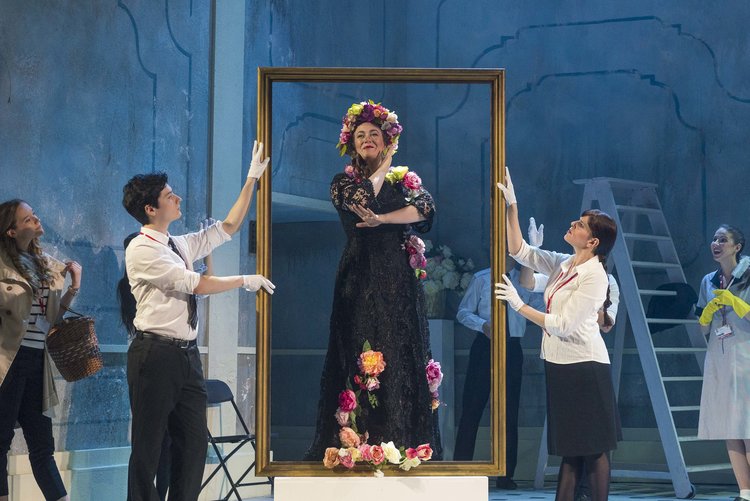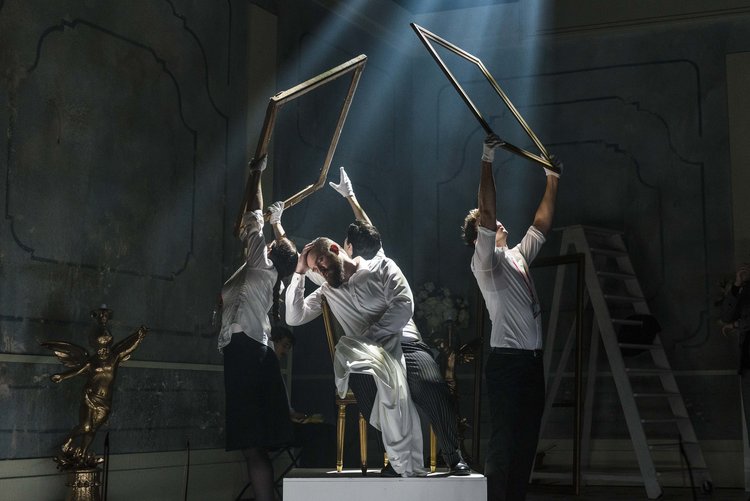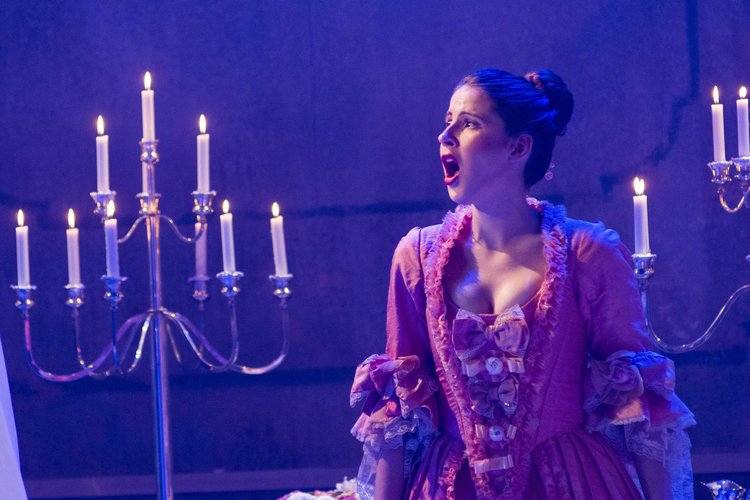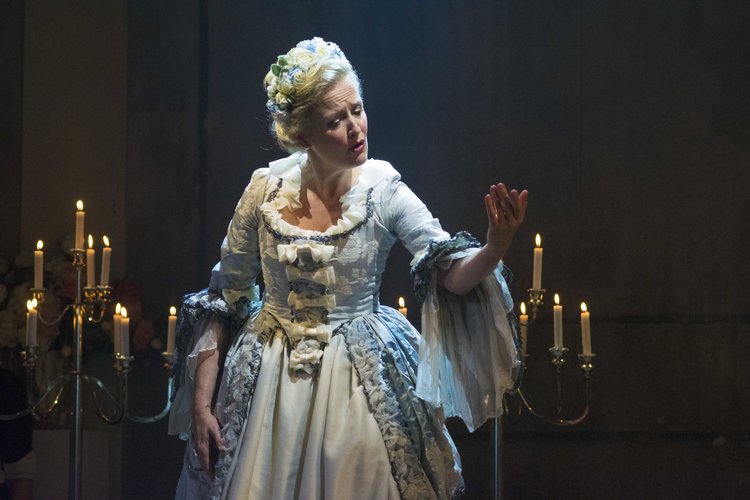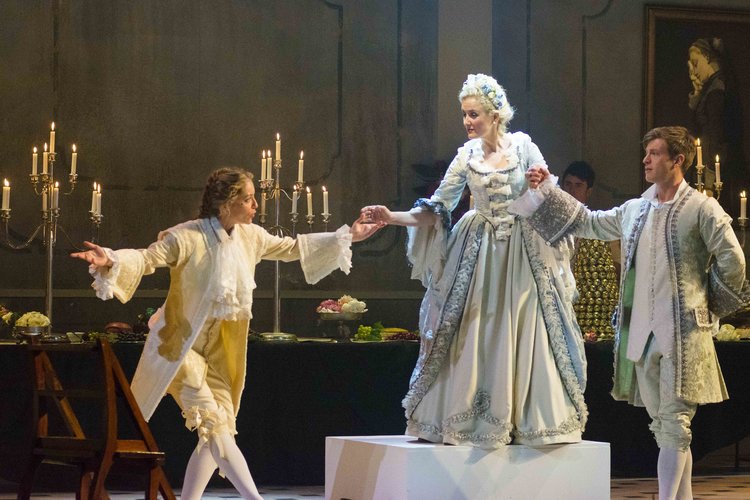Rameau: Anacreon & Pigmalion
A riotous evening of fabulous French opera.
Rameau Anacréon (libretto by Pierre-Joseph-Justin Bernard)
Rameau Pigmalion (libretto by Ballot de Sauvot)
Vinci Erighetta e Don Chilone (libretto by Vinci)
Thurs 15 June, 7pm | Sat 17 June, 2pm | Sun 18 June, 5pm | Tues 20 June, 7pm 2017
City Recital Hall Sydney
Rameau's Anacreon & Pigmalion
Celebrating the delights of love and booze this impeccably crafted triple bill was curated by our artistic director Erin Helyard. Showcasing some of Rameau’s most deliciously perfect and joyous music, contrasted with an Italian intermezzo in the style of the period, Taryn Fiebig led an outstanding cast of party-goers.
Erin Helyard says "We revive the intermezzo tradition in the best traditions of the genre of the acte de ballets themselves: which were sparkling, diverting, lyrical genres centred on a short story that revolve around the theme of love and pleasure. Get ready to rediscover opera as you've never heard it before!"
REVIEWS
READ
1] Jean-Philippe Rameau
Jean-Philippe Rameau lived a long life. Born in Dijon in 1683, he died, age 81, in Paris on 12 September 1764. His life overlapped those of Bach (1685-1750), Handel (1685-1759), Domenico Scarlatti (1685-1757) and Telemann (1681-1767).
Rameau has been described by a contemporary as having ‘a sharp chin, no stomach, flutes for legs’. He was extremely tall and thin; ‘more like a ghost than a man,’ recorded another. His father was an organist in Dijon, his mother a member of the lesser nobility.
Not much is known about Rameau’s early life. At 18 he was sent to Italy to study music but got no further than Milan. What he did there is not known but it seems he returned to France within a few months. Church records show him popping up in several places in France over the next 20 years, mostly as an organist on short-term contracts. The next confirmed sighting was in 1709 where he succeeded his father at Notre Dame Cathedral but he was gone from there by 1713 because in that year the city of Lyon was about to celebrate the Treaty of Utrecht. Jean-Philippe Rameau was appointed Musical Director for the ceremonies but the musical element was cancelled and the money given to the poor.
Rameau continued his nomadic wanderings, appearing in Dijon, Clermont and Lyon. He would sometimes sign long-term contracts as an organist and fail to honour them. A story of his escape from a contract at Clermont Cathedral has him composing a mass so awful that the chapter conceded that they could not keep a composer who wanted to leave. It was during this time, however, that he wrote his Traité de l’harmonie and Nouveau système de musique théorique. There are published keyboard works and cantatas from this time but Rameau was known as a theoretician before he was recognised as a composer.
By 1724 he was in Paris and, it seems, he never left. The following year two Louisiana Indians were ‘displayed’ in a theatre and Rameau wrote Les Sauvages to accompany their dances.
At age 42, Rameau married Marie-Louise Mangot. She was 19 and the daughter of a family of musicians. It seems to have been a happy marriage and produced four children, of whom one boy and one girl survived their father. Rameau continued his theoretical writings and worked as a ‘gigging’ organist – there is no record of any fixed appointment anywhere – and teacher.
Remarkably, Rameau only turned his hand to opera at the age of 50. After meeting Le Riche de la Pouplinière, a wealthy man who was to become his patron, Rameau produced Hippolyte et Aricie. It was performed privately at La Pouplinière’s house with his singers and orchestra. Shortly after, following Rameau’s 50th birthday, the opera was performed at the Paris Opera. The work created a storm. Lully was regarded as the gold standard for French opera. His followers, the Lullistes, were very unhappy about any departure from his rules.
Rameau continued to live as part of La Pouplinière’s household, composing operas and opera-ballets, and writing musicological works. Interestingly, it was these essays and treatises – more than his music – for which Rameau hoped to be remembered. Late in life he said he regretted time spent composing, as he could have spent it writing.
Castor et Pollux was an original product of 1737, but as with many of Rameau’s stage works underwent significant revision, before a much more successful restaging in 1754. A dramatically irrelevant prologue was omitted, and the conflicts of feeling within each character heightened in Act I. The reception this second time round was nothing short of ecstatic. A further, equally successful revival took place again ten years later.
It’s true that towards the end of his life Rameau found his creative powers weakening but his reasoning powers remained. He continued to write and just four months before his death he was ennobled by the Emperor. He seems to have had good health throughout his life until the fever from which he died on 12 September 1764. He was buried in St Eustache, near Les Halles. The precise site in the church is unknown though there is a plaque to his memory in one of the chapels.
By the time of his death, Rameau’s fame ensured a send-off with great ceremony. Three memorial services were held in Paris and others throughout France. His widow lived another 20 years, but nothing is known of his descendants.
Some described Rameau as mean, bad tempered, unapproachable and unsociable. But he had enemies and perhaps these were judgments coloured by disagreements. One story gives greater insight into his character:
Michel-Paul-Gui de Chabanon, a young friend (later a member of Académie Française, succeeded in the seat by Victor Hugo), saw Rameau at a performance of Castor et Pollux at Fontainebleau not long before his death. Chabanon records: I ran towards him to embrace him; he started abruptly to take flight and came back only on hearing my name. Then, excusing the weirdness of his welcome, he said he avoided compliments because they embarrassed him and he never knew how to reply.
2] Anacreon: The Story
A party is being held at the house of the poet Anacréon where his guests celebrate the god Bacchus, waited upon by Lycoris, Anacréon's mistress.
The party is interrupted by the arrival of Bacchus' priestesses. The break a statue of Cupid and abduct Lycoris. The astonished guests run away. Anacréon falls asleep and is woken by a storm and hears a distressed child crying. The child tells him that Lycoris has been abandoned by an ungrateful lover who has forsaken Cupid for Bacchus.
It gradually dawns on Anacréon that he is the guilty lover, and that the joys of wine have eclipsed the joys of love. He now recognises the child as Cupid, and throws himself at the God's feet declaring that if Lycoris is returned to him he will give up everything - without love all other pleasures are nothing. Cupid declares that wine should embellish love, but not disrupt it and effects a reconciliation with Bacchus.
3] Pigmalion: The Story
A sculptor, Pigmalion, creates a statue so beautiful and lifelike that he falls in love with it. His girlfriend Céphise begs for his attention, but he spurns her and asks the goddess Venus to bring his statue to life. The statue comes to life and magically begins to dance and sing.
Venus' assistant Cupid arrives and praises Pigmalion's artistic powers and faith. Cupid finds another lover for Céphise and there is much celebratory singing and dancing, attesting to the power of love.
4] Leonardo Vinci
Leonard Vinci was born in Strongoli, Italy in 1690. He studied composition at the Conservatorio dei Poveri di Gesù Cristo in Naples under the tutelage of Gaetano Greco.
Vinci debuted as an opera composer in 1719 with his comedy Lo cecato fauzo at the Tearo Florentini in Naples. He quickly became the theatre's main composer. In 1722 he tried his hand at more serious opera with Publio Cornelio Scipione at the Teatro San Bartolomeo, and it's immediate success led to him devoting most of his energy to dramatic opera thereafter.
His first commission outside of Naples occurred in 1724 when he composed Farnace for the Teatro delle Dame in Rome. His activity reached a peak in winter 1725-1726 when three new operas were produced, Astianatte in Naples in December, Didone abbandonata in Rome in January and Siroe re di Persia in Venice in February. He successfully began to create collaborations with librettist Metastasio.
Following the death of Alessandro Scarlatti in 1725, Vinci was appointed pro-vice Maestro at the royal chapel in Naples. He collaborated on the opera Medo and the ballet Le nozze di Nettuno for the wedding of the Duke of Parma. His summer was spent serving as the maestro of his former conservatory and S Caterina a Formiello where he served as maestro di cappella.
During 1729-30 Vinci became the principal composer and impresario for the Teatro delle Dame and continued his collaboration with Metastasio on three works, serenata La contesa de’ numi, and the operas Alessandro nell’Indie andArtaserse at the Teatro delle Dame. Vinci died soon after; with rumours that he had been poisoned.
5] Erighetta e Don Chilone
The young and lustful widow Erighetta wishes to remarry. She spies the handsome Don Chilone who lives a life of hypochondria and self medicates on enemas, tonics and pills.
Don Chilone is unhappy with his current doctor as he cannot save him and declares that his sickness will worsen. Erighetta persuades him to try her doctor, " Doctor Guarisci.". Unbeknownst to Don Chilone, Doctor Guarisci is purely Erighetta in disguise who proposes the only cure to his malady, Marriage. Only if she is a widow as a younger girl would be too immature
Don Chilone follows the doctor's orders and proposes to Erighetta. He proposes that Erighetta would be the lady of the house and decides to draw up a contract. Don Chilone and Erighetta marry. His strength returns and he is well again.
He curses his doctor who pretended to cure him. Don Chilone realises that marriage stresses him and he cares more for his health than his wife. Erighetta realises what a mistake she has made as she has married a man who already thinks he’s in his grave.
6] Acte-de-Ballet
An Acte-de-ballet is a short once piece act that includes dance and singing. It includes airs, duets, choruses and sometimes other vocal music and instrumental dances.
It often has continuous and slight dramatic action. The practice of giving several disparate works was central to the programming of the Académie Royale de Musique (simply called “the Opéra”) in Paris in the mid eighteenth century during the late reign of Louis XV.
ARTIST INFORMATION
Taryn Fiebig The Priestess of Bacchus (Anacréon)
The Statue (Pigmalion)
Erighetta (Erighetta e Don Chilone)
Richard Anderson Anacréon (Anacréon)
Don Chilone (Erighetta e Don Chilone)
Lauren Zolezzi Cupid (L'Amour) (Anacréon)
Cupid (L'Amour) (Pigmalion)
Samuel Boden Pigmalion (Pigmalion)
Agathocle (Anacréon)
Morgan Balfour Céphise (Pigmalion)
Erin Helyard Conductor
Crystal Manich Director
Alicia Clements Set Designer
Melanie Liertz Costume Designer
Matthew Marshall Lighting Designer
LISTEN
WATCH
Gallery
We acknowledge the traditional owners of the land on which we work and perform, the Gadigal people of the Eora nation – the first storytellers and singers of songs.
We pay our respects to their elders past and present.
CONTACT
PO Box 291, Strawberry Hills, NSW, 2012, Australia
Ticketing and Customer Service 02 9037 3444
ticketing@pinchgutopera.com.au
info@pinchgutopera.com.au

© COPYRIGHT 2002 - 2024 PINCHGUT OPERA LTD | Privacy Policy | Accessibility | Website with MOBLE

